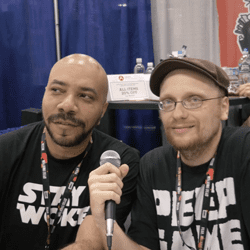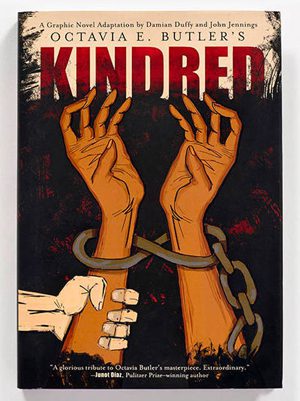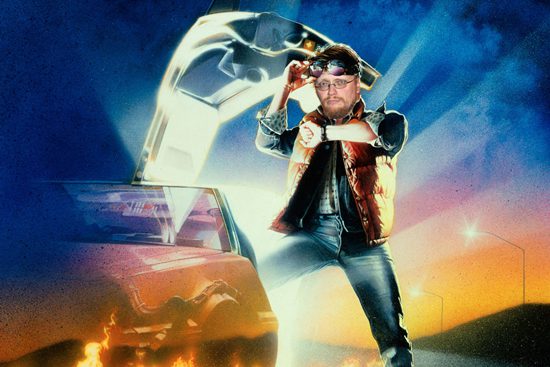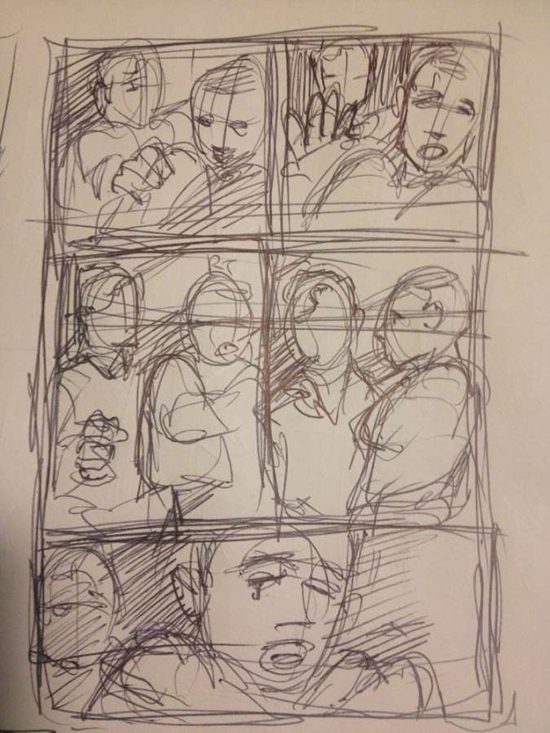
The Rumpus Book Club chats with Damian Duffy and John Jennings about their new graphic novel adaptation of Octavia Butler’s classic novel Kindred, the challenges of adapting a classic novel into a new genre, and whether or not Octavia Butler really was a time traveler.
This is an edited transcript of the book club discussion. Every month The Rumpus Book Club hosts a discussion online with the book club members and the author, and we post an edited version online as an interview. To become a member of the Rumpus Book Club, click here.
This Rumpus Book Club interview was edited by Brian Spears.
***
Brian S: So about this amazing graphic novel—can you give us a short version of how each of you came to work on this project, and maybe your history with Butler’s work?
John Jennings: You want to start Damian? It’s really not super short at all it seems…
Damian Duffy: Sure! Um… short version…
Brian S: No, I don’t imagine it would be a short story…
Damian Duffy: 2009: We submitted a proposal to a publisher called Beacon Press that was going to put out a Kindred graphic novel. We submitted but didn’t get the job.
John Jennings: Even the short story takes forever. 🙂
Damian Duffy: 2012: John met then-AbramsComicArts Sheila Keenan, who was looking for someone to make a Kindred graphic novel, because it turned out the 2009 adaptation never worked out.
Damian Duffy: And then we adapted it. The End. Hey! That was short! 🙂
John Jennings: That was haiku-like. Way to go, D!
Damian Duffy: We adapt Kindred
Time travel is upsetting.
Brian S: We jazz June?
Damian Duffy: Slavery is bad.
John Jennings: Ha! We die soon.
Damian Duffy: (That was actually a haiku.)
John Jennings: Very impressive.
Brian S: Were you looking to adapt this specifically?
Damian Duffy: But yeah, this was a dream job for both of us since a lot of our work making and curating and studying comics has been around representations of race, gender, and identity, which is exactly the territory Kindred explores.
S: What was the process like of adapting a novel into a graphic format? The art works really well with the content—was that intentional as part of this adaptation or just part of your art style(s)?
John Jennings: The visualization of the narrative was very difficult for several reasons.
Damian Duffy: Brian: The publisher was the one who had decided to adapt Kindred. We’re both big Butler fans, but we just sort of lucked into the opportunity. The second time.
John Jennings: Damian had the daunting task of figuring out a somewhat truncated version of the original story without sacrificing any of the theme or the underlying intent.. I went through many iterations of designs and methods of working and we didn’t want to make the art too over-the-top and visceral. There had to be a balance struck between the horror of what was happening and also the “grim fantasy” that Butler created.
Damian Duffy: (Our editor Sheila Keenan was also very helpful by mercilessly cutting things out of my first draft.)
S: I was definitely a little surprised at how ‘short’ the graphic novel seemed compared to the original work.
John Jennings: So, we ended up with something closer to a dark fairy tale that still kept notions of the grotesque, the uncanny, and the surreal in the mark making.
Damian Duffy: S: yep, we had a few less pages to work with than the actual novel, and you can do things in a paragraph of prose that might take multiple pages in comics. So that was a challenge
John Jennings: It was definitely a challenge.
S: That is really interesting! So each of you sort of took on your own task. Was there also collaboration between you on art and story as well?
John Jennings: By the way, Damian also did the lettering.
S: Thanks for sharing!
Damian Duffy: John and I have been working together for about twelve years now, so we’re pretty good at collaborating, although it took some getting used to having an editor involved as well, but it definitely made the book better.
John Jennings: So, it was a bit easier for him to edit things and move around dialogue. We also hired a team of five production assistants to help color the book.
S: I also think there are some things that work out really well (maybe better?) in the visual form. Using sepia tones for the ‘present’ is something that I think was almost ingenious.
Damian Duffy: I also copied and pasted one of John’s drawings from one image, and then shrunk it down in the background of another image. So I sort of did a very tiny bit of the art! 🙂
John Jennings: Oh yeah. I remember that!
Brian S: Did you letter by hand or have you created a font? (The Book Club read Isaac Fitzgerald and Wendy MacNaughton’s book, Knives & Ink, and I got curious about that subject.)
Damian Duffy: The production assistants did the color flats, dropping in basic colors on John’s art that he added shading and texture to.
John Jennings: Damian, what font did you use again?
Damian Duffy: I letter using Adobe Illustrator. I bought one font, and used a freeware font for the narration.
Damian Duffy: Manga Masters I think is the name of the dialog font. It’s a BlamBot one, I believe.
John Jennings: That would make sense. The book is colored in Photoshop but, the bulk of the original inks were done with various sizes of Sharpies. Most of which were created while traveling to speaking events.
Damian Duffy: Also, I did a bunch of blog posts that talk more in depth about the process of adaptation and what lead us to the project and things like that, if anyone’s interested.
John Jennings: And a wedding 🙂
Brian S: I was going to ask about that—a project this large almost has to be done while you’re doing other work. How hard was time management?
John Jennings: The thing is, I had managed to get a leave from teaching (I was owed one contractually) However, due to some editing shuffling, I ended up doing the bulk of the work with a full teaching load…
Damian Duffy: It was difficult, especially because circumstances beyond our control meant we had to work on the book while John was looking for a new job and I was finishing my dissertation.
John Jennings: Oh yeah! I forgot about that… (probably to protect my psyche). I essentially went through another tenure process when I got my new position out West.
Damian Duffy: Yeah, we had both set aside time to do the book, but that time passed before we actually got editorial notes to help us do the book.
Brian S: My partner just went through the tenure process. I don’t know how you manage to do anything while that’s going on.
Damian Duffy: And there were a good two weeks or so before the deadline where neither of us slept.
John Jennings: So, we ended up doing the bulk of the work during the most insanely busy time of both of our lives. We couldn’t let those things stop us though. Octavia Butler’s legacy is far too important.
Damian Duffy: Although that’s how these things always seem to work out.
John Jennings: Yeah. It does. Sigh.
S: Especially now… It is a bit weird how timely this publication is.
Damian Duffy: Oh yeah, we sacrificed sanity and probably cumulatively a couple years off our lives. But the book needed doing.
Brian S: I feel like I should ask if you’re doing Parable of the Sower next…
John Jennings: I know… I was just talking to a colleague about that very thing. It’s almost like the entire country time travelled backwards… just like Dana.
Damian Duffy: Honestly, I would probably prefer it not be so timely, and just a lovely work of literature, but… sigh. Here we are.
Brian S: Rufus Weylin does have a certain orange quality to his hair…
John Jennings: Yes! Rufus and his carrot top. We decided to make the past more vibrant because Butler talks about how real it seems… how much more colorful and memorable.
Damian Duffy: Rufus might show a tiny bit more respect towards women. But I digress.
Of course the Parables are basically a documentary of, like, next Wednesday.
John Jennings: Yeah. This is how the Parables start.
Brian S: Down to the year—they’re set in 2024, but they mention the 2016 elections being pivotal to what went wrong. Are we sure Octavia Butler wasn’t actually a time traveler?
John Jennings: Ohhh… now THAT’S a story! DIBS!!!
Damian Duffy: Octavia Butler travels back in time to team up with W.E.B. Du Bois to fight D.W. Griffith. Who has a demonic movie camera. Or something.
Brian S: Ida Mae Wells would have to have at least a cameo.
John Jennings: It writes itself.
LOL. Like we’d have time to do it.
Damian Duffy: We just have to learn to time travel, and the rest will take care of itself.
John Jennings: Oh yeah. They have time travel workshops here at the Cambridge Adult Education Center. Piece. O. Cake.
Brian S: Can you talk some about the way you worked together? Was there a script that turned into images on the page or did the art come first and the dialogue after? This is a world I know next to nothing about and I’m really curious about how this works as a practical matter.
Damian Duffy: With this project it started with the script, because the script went back and forth between the editor and me a few times. (We work different ways on different projects.)
John Jennings: Once, we had a “clean” script, I then took that script and sketched out each and every page into thumbnails. Then, those were edited in batches.
Damian Duffy: So there were maybe three or four drafts of the script until it got the okay from the editor. The script is sort of like a screenplay format, that describes what’s taking place in the panel and what dialog or narration will be in the panel
John Jennings: It was in what is called “full script.”
Damian Duffy: Here’s an example of one of John’s thumbnails:
John Jennings: Once, the thumbnails were edited I then began doing the pencils on the work. Then I did the inks for the entire book. That was then printed and turned into an Advanced Reader’s Copy for ALA.
Damian Duffy: In order to make the Advanced Reader’s Copy, I had to letter both the unfinished inks and/or pencils, and then re-letter the finished art.
John Jennings: Then once the inks were approved and finished… we started the coloring process. I assigned each of my flatters a particular section or sections. I sent them the black and white Photoshop files that Damian did.
Damian Duffy: (So, move word balloons and captions around if the locations of figures in the drawings changed a bit.)
John Jennings: They then sent me back the flat colors and then I did finishes which entailed shading, lighting, flourishes, etc.
Brian S: And this is a sizable book—over 230 pages—so this is a lot of time we’re talking about here. How long wold you guess it takes to go from thumbnails to a finished page?
John Jennings: Damian crated this “lettering window” (really ingenious) that not only had the lettering but, also the gutters. It made work a lot faster because we could then place the colored pages right UNDER the lettering.
Damian Duffy: After the script was finalized, I think we did the rest of the production in like eleven months.
John Jennings: We colored the book in like three weeks.
Damian Duffy: Of course, this is not a sane amount of time in which to do a project like this.
Brian S: Ha!
John Jennings: It was just necessary in order to make sure we got this out.
Damian Duffy: The motivating power of deadlines.
John Jennings: I think I just had a flashback. FIND A HAPPY PLACE. FIND A HAPPY PLACE. FIND A HAPPY PLACE.
Damian Duffy: I mean it was fine. IT WAS ALL FINE. We didn’t go insane AT ALL. Hee hee hee.
Brian S: Damian, when you were working on the script, how did you decide what you needed to leave out to make the adaptation work as a graphic novel?
Damian Duffy: Deciding what to leave out was challenging, but it ended up that I had to make sure to focus mostly on the main characters. So some minor characters were eliminated, or combined. Also I spent a lot of time thinking about what each scene revealed about the characters, or the time, and if there were two scenes that showed similar things about the characters, only one of those scenes could stay in.
John Jennings: I think that we also focused a great deal on trying to show what comics does as a medium. So, there were scenes that highlighted those aspects as well.
S: How much of the plot/story changes do you feel were part of your artistic direction as opposed to working within constraints?
Damian Duffy: S: The basic plot didn’t change much. I think the things that were left out ended up being left out largely in response to the constraints. The parts that changed as a result of artistic direction had more to do with how scenes were portrayed. We wanted to make sure we did things that only the comics medium could do. But yeah, so we have these little infographics and a map of the Weylin plantation in place of descriptive narration. Things like that.
John Jennings: Also, because comics are so symbolic, we were able to use color in a very particular way to convey story.
Brian S: What’s the reception been like so far? Or has it not been out long enough to hear anything yet?
Damian Duffy: We have received some of the best, most thoughtful reviews. And honestly, we were just hoping people wouldn’t hate it!
John Jennings: Seriously. We were just hoping that people didn’t hate it and that we did a good enough job that people wanted to go read the original and pick up all of Butler’s books.
Damian Duffy: But yes, the reception has been great, and it premiered at #1 on the New York Times bestseller list for hardcover graphic books, right before the NYT did away with that list…
John Jennings: But, people seem to mostly really like what we did.
Brian S: I mean, when I got an email from Maya asking if we’d be interested in covering it, I almost came unglued, in part because the email wasn’t really meant for me. It was meant for the other Brian [Hurley], the Rumpus Books Editor.
But I’ve been a Butler fan for a long time and have taught this novel before, so the chance to see this book get some more exposure was just amazing to me. And I knew even before I saw it that I wanted it for the book club. I’m so glad we were able to make it work.
Damian Duffy: Thank you!
S: I was actually about to purchase a copy right before I got it in the mail from Brian.
John Jennings: Yes! So many, many people love this book. Seriously. Thank you.
Damian Duffy: So many, but not nearly enough. Kindred is like the great American novel that Americans don’t discuss.
John Jennings: I meant the original book btw. 🙂
Brian S: It feels weird to say it, given the accolades Butler won in her lifetime, but I really feel like she’s under-appreciated as an author.
S: I have found that the people I know and talk to about Butler tend to be women and people of color.
Damian Duffy: Definitely. She was appreciated in certain circles, but never really gained the mainstream acclaim that we feel like was her due.
John Jennings: Yeah. And that’s the crime. Her work inspired a whole generation of dreamers and authors. Hopefully, this gets her more into the consciousness of the mainstream. She deserves it.
Damian Duffy: Yep, she was hugely inspirational to so many women of color, so many artists, it’s about time the world recognizes.
Brian S: Right, John. and certainly part of that is the unflinching way she shows racism and the horrors of slavery and rape. This is such a potent story—how has it not been made into even a shitty movie yet?
John Jennings: Exactly! It seems the rights have been bought many times… even now. HOPEFULLY, something comes of it. Only time will tell. In the right hands, at the right studio… it be an amazing thing. Painful. But, amazing.
Damian Duffy: Apparently Kindred has been optioned several times for film, but it never got off the ground.
S: I definitely got the impression (as you noted) that this is about getting people to read and explore Butler’s works as well.
John Jennings: Exactly. It’s really about people going out and discovering Butler’s work.
Damian Duffy: S: Oh good. We definitely hope our work helps spread and cement Butler’s legacy as an author and… genius.
S: With that, I liked how you had a nice bio and a Butler bibliography at the end.
John Jennings: Yes! That’s my favorite image I’ve done of her too.
Brian S: Who would you cast as Dana if you were able to make this into a movie?
John Jennings: That’s a good question! Let’s see…
Brian S: I mean, besides Angela Bassett, because that’s the answer to every question as far as I’m concerned.
John Jennings: Adepero Oduye from that film PARIAH.
Brian S: I was thinking maybe Simone Missick from Luke Cage.
Damian Duffy: Maybe Emayatzy Corinealdi from Middle of Nowhere
Brian S: I’m going to tag all these people in the final edits of this chat and see if their Google alerts give them any ideas. 🙂








